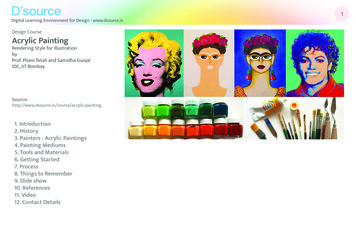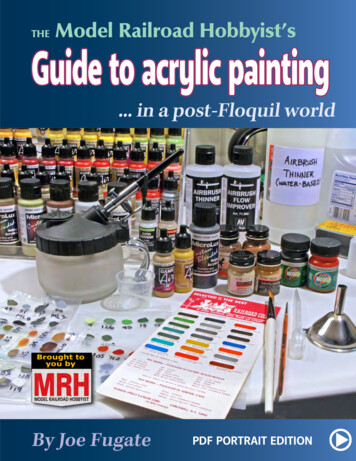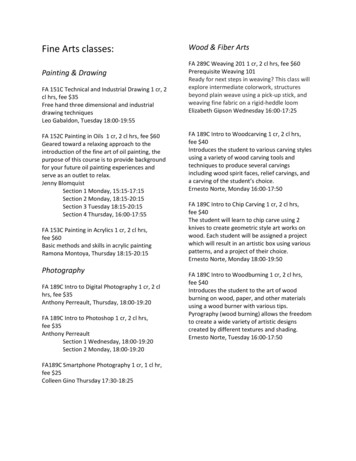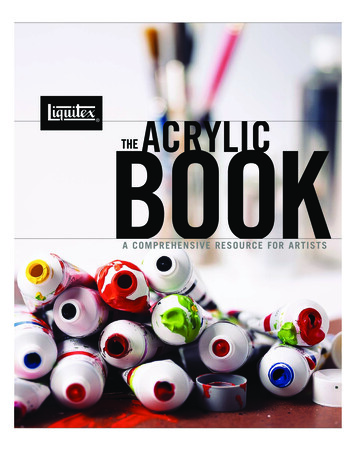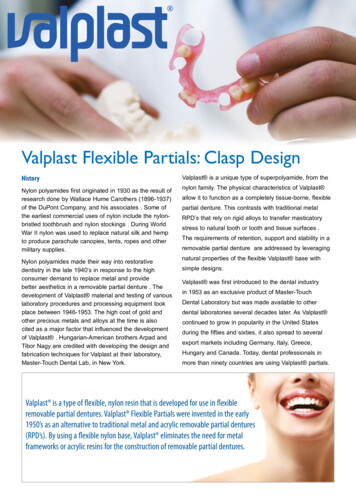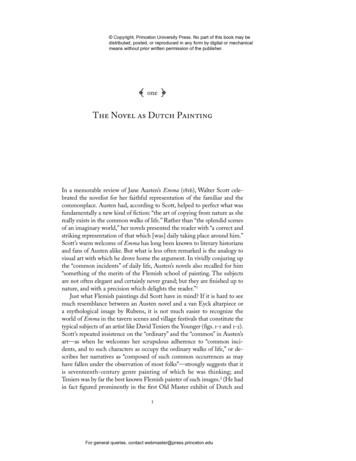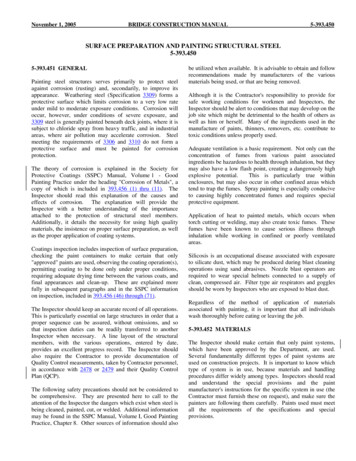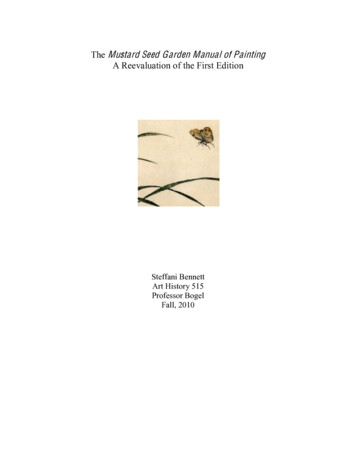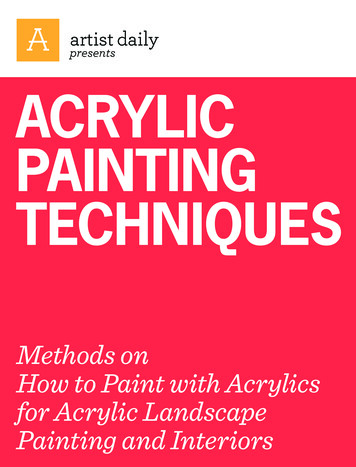
Transcription
presentsACRYLICPAINTINGTECHNIQUESMethods onHow to Paint with Acrylicsfor Acrylic LandscapePainting and Interiors
ACRYLIC PAINTINGTECHNIQUESRounding the Bend2009, acrylic, 20 x 30.This painting won first prize in the acrylic category of the American Artist/Utrecht paintingcontest in 2009. All images this article collection the artist unless otherwise indicated.Compose & PaintVaried Landscapes With AcrylicsWhen Jeanette Chupack moved from Vermont to Florida andbecame an avid kayaker, she had to adapt her acrylic-paintingprocedures to respond to the complicated, repetitive patternsshe observed along the waterways of the Sunshine State.by M. Stephen DohertyThis content has been abridged from an original article written by M. Stephen Doherty. F W Media, Inc. All rights reserved.F W Media grants permission for any or all pages in this premium to be copied for personal use.2www.artistdaily.com
ACRYLIC PAINTINGTECHNIQUESIt took Jeanette Chupack a couple ofyears to adjust to the landscapes sheobserved while kayaking along thewaterways near her home in CapeCoral, Florida. The new locales werequite different from the rolling landscapes she used to observe and paintin Vermont. “The Florida landscapepresents its own challenges becauseit is flat, filled with wildlife and tropical plants, and saturated with moistatmosphere during most of the year,”Chupack explains. “I was excited aboutdiscovering the scenery, especially asmy husband and I spent more timekayaking along the network of waterways. It took me two years to develop agood painting from the images logged3www.artistdaily.comin my mind. I had to find a way ofseeing the spaces and vegetation in acompletely different way, and I had toconsider a new approach to composingthe elements into acrylic paintings.”About the same time Chupackmoved her studio, she changed fromusing photographic film to digitalmemory cards in her camera. “I’vealways used photographs as a key pieceof source material, but in the past Irelied on slides and prints to catalogpotential images, and I had to adjustfor the differences between what Iremembered and what the film andprocessing presented. With digitalphotography, I have instantaneous andcomplete control over the informa-Sparkling Waters2008, acrylic, 8 x 10.Private collection.
ACRYLIC PAINTINGTECHNIQUEStion recorded on the spot. I bought awaterproof Pentax camera I could usewhile kayaking, and now I immediatelyreview the photographs—even the onesI take underwater.”Chupack also bought an LCD projector so that she can enlarge the full ordetailed digital photographs when shewants to refer to them while painting.The projector also allows her to tracethe images directly on to her gessoedcanvas using a graphite pencil. “Thelandscape is often a densely compacteddisplay of repeated colors, shapes, andpatterns, so I start with one photographand then adjust the projected drawing to get a stronger, more focusedcomposition,” she explains. “I mayhave to take elements from five or sixphotographs—some detail shots, somewide-angle views—in order to haveone center of interest and a hierarchyof supportive shapes and colors. I lookfor those kinds of elements as I movealong a river so that I have enoughinformation when I’m painting in mystudio.“The light is very important in alandscape, and I may pass a locationhundreds of times before the patternof light and shadow makes it visuallyappealing,” Chupack continued. “Assoon as I see that kind of pattern, I takelots of photographs because I knowit will help in adding interest to whatmight otherwise be an average scene.Back in my studio, I play around withthe digital image in the computer bychanging the colors or levels of contrast or by cropping, using the editingoptions in Photoshop or Picasa. Mybiggest challenge is usually trying to4www.artistdaily.comABOVELady SlipperOrchids2006, acrylic,131 2 x 101 2.LEFTStepping Out2009, acrylic,33 x 42.
ACRYLIC PAINTINGTECHNIQUESsimplify and focus the composition.“It is important for artists to workfrom life so that they can bring anin-depth understanding to their interpretations of photographs,” Chupackinsists. “Photographs flatten the spacesand distort colors and values, andunless one has drawn and painted fromlife, he or she won’t know how to compensate for those distortions. BeforeI could ever work from photographsI put in years of time working on-sitefrom still life arrangements and fromthe figure. In fact, I ran a life-drawingclass every week for about 15 yearswhen I was living in Vermont.”Once Chupack is satisfied withthe edited photograph and has thebasic outline of the forms projectedand traced on the canvas, she beginsbuilding up layers of acrylic paint.“I stretch and prepare the canvases5www.artistdaily.commyself by sealing them with severallayers of acrylic gesso mixed with asmall amount of yellow ochre to givethe painting surface an off-white tone,”she explains. “When the surface of thecanvas is dry, I secure it into one of twoRicheson easels I have in my studio—one handles small paintings and theother can hold big ones.“I apply a coat of retarder over theentire canvas to slow the drying timeof the paint, and then I block in all theareas of the picture with an approximation of the local colors so that I canquickly assess the strength of the composition,” Chupack says. “Continuingwith Golden heavy-body acrylic paints,I focus on building up the layers fromthe background shapes to those in theforeground. The exception to that progression is when there is a large bodyof water in the painting and I need toGrand Old Cypressof Prairie Creek2007, acrylic, 20 x 30.
ACRYLIC PAINTINGTECHNIQUESblock that in fairly early in the painting’s development so that I can judgethe balance of colors and values. Ialways avoid getting caught up in painting details because I have to make surethe picture holds together before I startfussing over details or applying glazesof tone.”Chupack says she does a lot of glazing with Golden or Utrecht brands ofpaint thinned with semigloss soft gelmedium. “I layer closely related colorsand values, notcomplimentary colors,” she says. “It’smy way of unifying the brushwork ofthe fast-drying acrylic paint that has atendency to look fractured and dull ifit isn’t adjusted. Layering and glazinggive the painting more resonance anddepth of color. I use synthetic brushesfor most of the painting process, but6www.artistdaily.comI do switch to bristle brushes when Iwant to push the paint harder whenpainting something like clouds, or Iuse sable brushes when I want to addlinear details. I also have a fan brushavailable for painting grass and onegiant sable brush I can use for paintingbig areas quickly.”Chupack says she usually has fouror five paintings in her studio that arein various stages of development, butonce she has a clear vision of how apainting needs to be completed shewill concentrate on that one imageuntil it is resolved. “I tend to concentrate on a painting until I finish it,and then I sketch ideas for severalother paintings on stretched, tonedcanvases,” she explains. “I may leave awork unfinished for as much as a yearbefore I decide what it needs. I seldomClear Day, Prairie Creek2008, acrylic, 20 x 30.
ACRYLIC PAINTINGTECHNIQUESTelegraphCreek Oak2008, acrylic,30 x 20.7www.artistdaily.com
ACRYLIC PAINTINGTECHNIQUESgive up on a painting and like the factthat acrylic allows me to quickly makechanges without having to wait daysand weeks for the layers of paint to drythoroughly.”Once her paintings are completed,Chupack applies a coat of high-glossmedium over the entire surface unlessthe canvases are especially large. “I liketo add a layer of protection, and I findcollectors are more receptive to paintings with a glossy finish because theyare accustomed to looking at oil paintings,” she explains. “If the canvas isreally large, I use a semigloss mediumover the surface because high-glossfinishes often create so much glare thatit is difficult to see the entire image at8www.artistdaily.comone time.”Chupack sells herpaintings through commercial galleries and hergiclée prints on the internet. The prices for originalpaintings range from 500 to 900 for small(8”-x-10”), unframed canvases up to 7,000 for a40”-x-60” unframed painting. Her prints sell from 40 for an 8”-x-10” imageup to 250 for a 20”-x-30”print. Some of her printshave recently been published as part offund-raising programs sponsored byenvironmental groups. nABOVETOPGreen TurtleOsprey Nest inFlorida Bay2008, acrylic, 33 x 42.Private collection.2009, acrylic, 17 x 22.
ACRYLIC PAINTINGTECHNIQUESABOUTTHE ARTISTJeanette Chupack earned a B.F.A.from Syracuse University, in NewYork, and an M.F.A. from IndianaUniversity, in Bloomington, andshe attended the Yale SummerSchool of Music and Art, inConnecticut. She taught at anumber of institutions, including the University of Vermont, inBurlington, and she has conductedpainting workshops. She currentlymaintains a studio in Cape Coral,Florida. For more information, visitwww.jchupackart.com.9www.artistdaily.comStill Life for a Summer Afternoon2007, acrylic, 40 x 60.
ACRYLIC PAINTINGTECHNIQUESArtist Daily Step-by-StepBeginner Painting TipsLearn acrylic painting in 7 steps. by M. Stephen DohertyThis content has been abridged from an original article written by M. Stephen Doherty. F W Media, Inc. All rights reserved.F W Media grants permission for any or all pages in this premium to be copied for personal use.10www.artistdaily.comThe rooms inside private homes, historical museums, and public buildingsmake excellent subjects because theygive artists the chance to create interesting relationships between adjoiningrooms, reflective windows and mirrors, contrasting natural and artificiallight, and organized furnishings. Thecool light from a table lamp in a livingroom can be shown close to the warmsunlight of a nearby kitchen. A heavyVictorian sofa can be balanced by adelicate spindle-backed chair. And a sixfoot hall mirror can reflect the imagesof people sitting in an adjacent room.All of these possibilities can be exploredin paintings derived fromGame Room,photographs, drawings, orSims House,on-site studies of interiors.1996, acrylic,Ronald Lewis became14 x 10. Privatecollection.interested in paintinginteriors when he beganto grow bored with the oil landscapeshe had been producing for a numberof years. “I was getting burned out,” heexplains. “And even though I loved thesmell of oils, I felt I could really takeadvantage of the fact that acrylics dryso much faster. I decided to focus onacrylic paintings of interiors, a subjectI had explored on occasion but neverreally focused on. I quickly discovereda whole range of possibilities with thesubject and the medium.”Lewis is one of many artists whohave added acrylics to their repertoire ofpainting mediums. While oil paints andvarnishes have qualities that can’t be
ACRYLIC PAINTINGTECHNIQUESmatched by other paints,Guest Room,Sims Housethey dry slowly and re1996, acrylic,quire the use of mineral14 x 10. Privatespirits, turpentine, orcollection.other potentially hazardous solvents and mediums. Acrylicpaints are mixed with water and canbe altered with water-based acrylic mediums and additives to increase theirthickness, extend their drying time,and modify their finish. Furthermore,acrylics dry quickly and permanently,making it possible to paint additionallayers of color over them within a matter of minutes.Lewis came up with the idea ofpainting interiors while visiting thehomes of friends in Birmingham,Alabama, where he lives. He asked totake photographs and make sketches ofthe rooms and later used that material in his paintings. Once he decidedto create more such works, the artistmade a trip to the historical town ofEufaula, Alabama, which, because of itsposition on the Chattahoochee River,once prospered from the riverboatsthat passed on the way to the Gulf ofMexico. Wealthy families built large,ornately appointed homes there thatLewis now finds to be excellent subjectmatter. The paintings shown in thisarticle depict rooms in one of theartist’s favorite homes in Eufaula, theSims house.Even though he begins his paintings by referring to photographsand sketches of actual rooms, Lewischanges things so radically that thepaintings seldom end up lookinglike the actual locations. “One of theadvantages of acrylics is that as long asI keep the paint relatively thin duringthe initial stages, I can make whateverchanges I want,” the artist explains.11www.artistdaily.com“I can add and subtract furniture,re-create the framed pictures on thewalls, and change the colors and patterns in the room with no problems.I once turned a canvas on its side andconverted a horizontal picture into avertical one.”Sometimes Lewis paints onwatercolor paper, watercolor board,or Masonite, but about half his acrylicpaintings are done on Fredrix acrylicprimed canvas. The acrylic paints areversatile enough to also be applied towood, paper, or certain plastic panels.Beginning with thin applicationsof paint and later switching to thicker,more opaque brushstrokes, Lewis takesadvantage of the fact that most manufacturers of acrylic paints sell botha fluid and a thick formulation. The
ACRYLIC PAINTINGTECHNIQUESGuest Room, Sims House(Second Impression)1996, acrylic, 14 x 10.This painting and the one on theprevious page show the sameinterior, and show the diversity ofLewis’ approach to acrylic painting.He sometimes prefers a loose,gestural style rather than a tight,detailed presentation.fluid colors are usually sold in jars orsqueeze bottles, making it convenientto work with thin paint. The thickerformulations are usually available instandard paint tubes or in jars. Lewis’palette normally includes the followingcolors: titanium white, burnt umber,burnt sienna, yellow oxide, raw sienna,cadmium orange, cadmium yellow,Hooker’s green, dioxazine purple,Grumbacher’s alizarin crimson, cad-12www.artistdaily.commium red, and Mars black.During some phases of a painting’sdevelopment, the artist may add Golden’s acrylic retarder to thin the paintsand slow the drying process. This stepis particularly important when he is trying to establish a subtle blend of colorsor a soft transition between adjacenttones and needs to keep the paint fromdrying too quickly. But once a paintinghas been completed, he applies a coatof acrylic gloss medium, which bringsout some of the underlying colors andgives the picture the glossy surface ofan oil painting.The artist sells most of his paintings through commercial galleries, buthe also exhibits in a few national andregional outdoor festivals. “Most of mysales occur in the spring and fall, so Itry to get my work out as much as possible during those times of the year,” heexplains. “The best outdoor shows areusually the ones that are juried, and it’sa good idea to exhibit in the same showfor several years in a row so collectorscan become familiar with your work.”Lewis graduated from AlabamaCollege (now the University of Montevallo) in 1967. He has received nearly100 awards for his oil, watercolor, andacrylic paintings in juried shows organized by the American Watercolor Society, Watercolor U.S.A., the SouthernWatercolor Society, Arts for the Parks,and other national organizations. Hehas illustrated two books, My CountryRoads and Papa’s Old Trunk (both BuckPublishing Company, Birmingham,Alabama). Lewis’ paintings have beenfeatured in Southern Accents and are inmany private and corporate collectionsas well as in those of the BirminghamMuseum of Art and the Fine Arts Museum of the South in Mobile, both inAlabama, and the Columbus Museum,in Georgia. nTURN THE PAGE FOR ASTEP-BY-STEP
ACRYLIC PAINTINGTECHNIQUESDemonstration:Reading Chair, Sims HouseStep 1After making arough graphitedrawing on acrylic-primed canvas,Lewis applied athin underpaintingof burnt siennaand burnt umber.1234Step 2He then blockedin the walls withcadmium orange,yellow oxide, andtitanium white.Step 3The fireplace andhanging pictureswere then paintedwith Hooker’sgreen and yellowoxide. He tonedthe picture downwith dioxazinepurple and titanium white.Step 4Next, Lewispainted thechair. He addedsome Golden’sacrylic retarderto increase thedrying time of thepaint so he couldblend detailsbefore the paintdried.13www.artistdaily.comContinued.
ACRYLIC PAINTINGTECHNIQUESStep 5This detail shows how Lewisused a white charcoal pencil to draw the table andbooks more carefully beforepainting them.Step 6Finally, he blocked in thebed and rug using blue,red, purple, and burntumber with titanium white.5Reading Chair, Sims House1996, acrylic, 18 x 14.Courtesy Bryant Galleries,Jackson, Mississippi, andNew Orleans, Louisiana.614www.artistdaily.com
ACRYLIC PAINTINGTECHNIQUES5Acrylic ArtistsShare Methods, Materials,and Techniquesby Karyn Meyer-BerthelDiligentby John Garrison,2007, acrylic, 48 x 36.Private collection.This content has been abridgedfrom an original article written byKaryn Meyer-Berthel. F W Media,Inc. All rights reserved. F W Mediagrants permission for any or allpages in this premium to be copiedfor personal use.15www.artistdaily.com
ACRYLIC PAINTINGTECHNIQUESJOHN GARRISONChicago artist and illustrator John Garrison usesacrylic paints and mediums because they behavesimilarly to oils but dry much faster.John Garrison has always been interested in architecture anddesign. “Because I am a graphic designer and illustrator, I amattracted to the simplification and stylization of images,” he says. “Iadmire both the Art Nouveau and Art Deco movements, and I amenamored with the extant structures designed by architect LouisSullivan (1856–1924).” Garrison’s figure paintings incorporateelements of Art Deco objects and architecture, and his subjectsare also portrayed in motion. “I look for subjects that allow meto convey a sense of movement and energy,” he explains. “I workfrom photographic references, sometimes combining multipleimages in the final painting. If I could afford to use live models, Iwould, but that’s just not practical.”Acrylic is Garrison’s preferred medium because he feels itgives him more control over the painting process. “Acrylics aregreat because they can behave like oils but dry much faster, andcleanup requires only water—plus, they don’t fill the air with thesmell of solvents,” he says. “I use Liquitex acrylics because they’reof a high quality, and I can count on their performance.” The ability to trust his products is yet another way Garrison can exercise16www.artistdaily.comIron Crossby John Garrison, 2007, acrylic,24 x 48. Private collection.
ACRYLIC PAINTINGTECHNIQUEScontrol, which in turn allows him to workmore quickly. Because he knows howhis materials will behave, he can focussolely on realizing his vision—somethinghe likes to do as fast as possible. “I’mimpatient, so I often work with a brushin one hand and a blow-dryer in the otherto speed up the drying process,” the artistexplains. “If I need to extend the drying17www.artistdaily.comtime of acrylics, I mix them with mattemedium. Although the paints normallydry to a matte finish, I coat some areasof the dry painting with gloss mediumso that the final piece has a visual playbetween the two finishes.”For more information on Garrison, visit his website atwww.garrisonart.com.Convergenceby John Garrison, 2007,acrylic, 36 x 36. Privatecollection.
ACRYLIC PAINTINGTECHNIQUESMack Truck Dogby LJ Lindhurst, 2007,acrylic, 36 x 36.Collection the artist.LJ LINDHURSTBrooklyn artist LJ Lindhurst createslarge-scale paintings of everyday objects torecord details of our culture.“I am a photorealist painter, and I want my paintings topresent reality without an obvious style or embellishment,”says LJ Lindhurst. “Because of that philosophy, I reproducethe photographed image as accurately as possible. Form,composition, and style occur naturally and are illuminatedby this neutral approach. That’s why I work from my ownphotographs or images lifted from mass-media sources, suchas print advertising and television-screen shots.18www.artistdaily.com
ACRYLIC PAINTINGTECHNIQUESLock No. 3by LJ Lindhurst, 2005, acrylic,48 x 24. Collection the artist.“Thematically, the subjects of mypaintings are varied,” Lindhurst adds. “Iam attracted to macro views of totemsof popular culture such as toys, Easterbunnies, chocolates, shiny metal locks,dolls, and other seemingly innocuous items. By closely examining theseotherwise ordinary images and rendering them several hundred times theirnormal size, I can capture an unusualsensuality and uneasy sense of comedy.Other artists might consider this painting process to be tedious, but I find it tobe engrossing and quite relaxing. Afterseveral hours work, I enter a meditativestate, and it’s in these moments thatI see subtleties in the colors, shading,or tiny imperfections in the surface ofobjects. Flat areas suddenly reveal amore complex palette and details thatmight otherwise be overlooked.”Lindhurst works with acrylic paintsdiluted with small amounts of waterand Liquitex Flow Aid, which allowsher to control the opacity of the colors.She also turns to Liquitex for paints,although she likes blacks and whites byGolden Artist Colors. When she wantsto create the illusion of depth, shemixes paints with varnish or gloss gelmedium. “I also use gloss gel mediumif I want to make one color more luminous, and in those situations I paintseveral transparent layers of a color sothat it doesn’t end up looking flat,” sheexplains. “I use the traditional processof working from dark to light values,layering colors of varying opacities ontop of one another. A typical large-scalepainting can take anywhere from threeto six months to complete, although Ican sometimes finish a smaller or lessdetailed piece in a matter of weeks.”For more information on Lindhurst, visit her website atwww.ljlindhurst.com.19www.artistdaily.com
ACRYLIC PAINTINGTECHNIQUESThe Diverby Dan Mandish, 2006,acrylic on board,21 x 21. CourtesyFor Artsake Gallery,Newport, Oregon.DAN MANDISHAs a professional illustrator and graphic artist, DanMandish uses a traditional thin-to-thick paintingtechnique, sometimes blending colors and softeningedges with a brush loaded with water.“My work is concept-driven and focused primarily on naturalistic subjects,” says Oregon painter Dan Mandish. “I workfrom my own photographs, and from these I typically makedetailed drawings before I begin to paint.” The artist works ina variety of media and produces a substantial amount of workin acrylic. Although acrylic paints don’t require an artist toadhere to the fat-over-lean or thick-over-thin dictum, Mandish employs these oil-painting techniques in his paintingprocess. However, he accommodates the fast drying time ofthe acrylics by following strokes of paint with applicationsof pure water. “My preference is to work on smooth panels20www.artistdaily.comcoated with gesso ground and tonedwith a middle-tone earth color such asa combination of raw sienna and terrarosa,” he explains. “I then block in theimages using thin washes of the darkestcolors and work up to the lightest values, gradually increasing the thicknessof the paint applications.“The exception I make with acrylicis in blending colors,” Mandish goes onto say. “I use two brushes, one loadedwith pigment and the other holding purewater, so I can apply paint and then immediately feather one value into another.I experimented with adding acrylicretarding mediums to slow the dryingtime of acrylics and facilitate blending,but I still find that working with the twobrushes gives me more control.” The artist uses sable or sable-synthetic brushesin a wide variety of sizes.“I prefer Liquitex colors because I’veused them from the start,” Mandishsays. “I know what to expect fromthem, and I’m intimately familiar withthe available color selections, includingwhich colors have high tinting strength,which colors mix well to create neutrals,and which are stiff when squeezed froma tube. These variables differ considerably between paint manufacturers.”For more information on Mandish, visit his blog athttp://saltandlighteditions.wordpress.com
ACRYLIC PAINTINGTECHNIQUESDAAN HOEKSTRADaan Hoekstra, an artist based in Sonora,Mexico, uses raw pigments mixed with acrylicbinders to create translucent murals on masonry.Daan Hoekstra is a classically trained landscape, still life, andfigurative painter, and he received much of his training inthe atelier system under Richard Lack. During his time as astudent, Hoekstra began painting murals, working as a buonfresco assistant for artist Mark Balma in the 1980s, and todaymany of his commissions still come from mural work. He21www.artistdaily.comHumanity at theCrossroadsby Daan Hoesktra,2008, acrylic, 24’ x 90’.Courtesy Grand RapidsCommunity Foundation.
ACRYLIC PAINTINGTECHNIQUESconsiders his approach methodical, andhis choice of materials is determinedby what will increase the longevity ofhis work. “I try to use conservators’materials and processes when possible,so I usually start with a coat of LascauxHydro-Sealer to the masonry,” Hoekstraexplains. “Hydro-Sealer is a consolidantfor old masonry, but it is also recommended by Lascaux to prepare surfacesbefore applying the company’s muralprimer. Because it is transparent, thenatural color of the masonry remainsvisible, and I often use that as thehalf-tone value in the mural. If I haveto block out some or all of the originalcolor of the wall, I use a translucentwhite primer thinned with water.”Hoekstra’s experience using traditional fresco techniques made it easy forhim to switch to using modern acrylicresins. “When the halftone is establishedon the wall, I lay in the darks transparently, using raw pigments mixed withacrylic binder,” he explains. “I makea paste of the pigments and distilledwater, and then I add an equal volumeof acrylic color. This mixture can thenbe thinned with water, although thepigment tends to sink to the bottom ofthe paint bucket and must be stirredwith the brush each time I dip into it.With a little practice, I learned to controlthe concentration of the pigment in thebrush according to the amount of swishing and the rate of settling.“After I have laid in the darks, I paintthe light-valued shapes with translucentto opaque matte white acrylic,” Hoekstra adds. “Then I finish the mural with22www.artistdaily.comthin glazes that add color to the lights,develop the halftones, and deepen thedarks. I operate on the assumption thatif the paint is allowed to soak into themasonry (rather than sit on the surface)it will be less likely to peel. For a finalvarnish, I follow the specificationsprovided by Golden Artist Colors andapply an isolating coat of soft gel and aUV-resistant clear varnish.”For more information on Hoekstra, visit his website atwww.hoekstrastudio.com.La Quintera Muralby Daan Hoesktra, 2008, acrylic,18' x 40'. Courtesy the MunicipalCultural Development Program,Sonora, Mexico.
ACRYLIC PAINTINGTECHNIQUESJewelby Jeanine Leclaire2008, acrylic, 32 x 24.Private collection.JEANINE LECLAIREPhiladelphia artist Jeanine Leclaire choseacrylic paints and mediums because she wantedto have complete flexibility in designing herpictures and expressing her concepts.Like many artists, Jeanine Leclaire works from photographsbut doesn’t allow them to define her final work. “The endresults have to stand as works of art without regards to thephotographic sources,” she says. “I focus on everyday moments, with an emphasis on those that conjure emotional23www.artistdaily.com
ACRYLIC PAINTINGTECHNIQUESFragileby Jeanine Leclaire2009, acrylic, 6 x 5.Collection the artist.responses. I often paint my husband,friends, and their surroundings becausethose make up my life. I keep mycamera handy and photograph peopleand places without telling people howto pose or what objects to have in theshots. As I am taking the photographs Iconsider composition and content, butI do so with the knowledge that I canalter anything I want when I’m painting. The final decision for what I useis made after I print the photos. I’ll laythem all out and choose the ones that‘speak’ to me. I’ll also use other photosto add to the one I’ve chosen, andsometimes even bits from the media,and my imagination will make its wayinto my paintings.“After I decide what I will paint, Idraw directly onto the gessoed woodpanel and establish the foundations forthe composition,” Leclaire goes on toexplain. “After I start painting, I remainflexible and move things around because some aspects of the picture won’treveal themselves until I am halfwaythrough the painting process. Next, Iblock in the shadows with black, add24www.artistdaily.comthe highlights with white or light colors,and then move the paint around until itlooks right to me. Decisions are madeas much in response to my feelings asto anything else.” Leclaire uses a paletteof professional-grade Utrecht acrylicsthat includes cadmium red extra deep,cadmium red medium, cadmiumyellow, ultramarine blue, brilliant blue,ivory black, and titanium white. nFor more information on Leclaire, visit her website atwww.jeanineleclaire.com.
Topp Resources for ArtistsLive!ONLINE ART COURSESWITH JOHANNES VLOOTHUISIMPROVE YOUR PAINTING SKILLS !“I struggled for yearswith composition,Learn painting essentials from popular art instructorJohannes Vloothuis, as he shares his simple, effectiveetc. Then I stumbledJohannes has taught thousands of students in work-upon your Wetshops and online courses and can help you becomepresto, within weeksthings just clicked.from YOURFAVORITE ARTMAGAZINES!ES!The Artist’s MagazineItem #U4690approach for painting a variety of landscape elements.value, color harmony,Canvas Webinar and,2011 ANNUAL CDCDsWatercolor ArtistItem #U4692a better artist, no matter your medium or skill level.Expand your knowledge, overcome those obstacles,improve your skills and create better paintings now!The Pastel JournalalItem #U4691You have given methe tools to createand blossom. Thankyou ever
the figure. In fact, I ran a life-drawing class every week for about 15 years when I was living in Vermont.” Once Chupack is satisfied with the edited photograph and has the basic outline of the forms projected and traced on the canvas, she begins building up layers of acrylic pai

